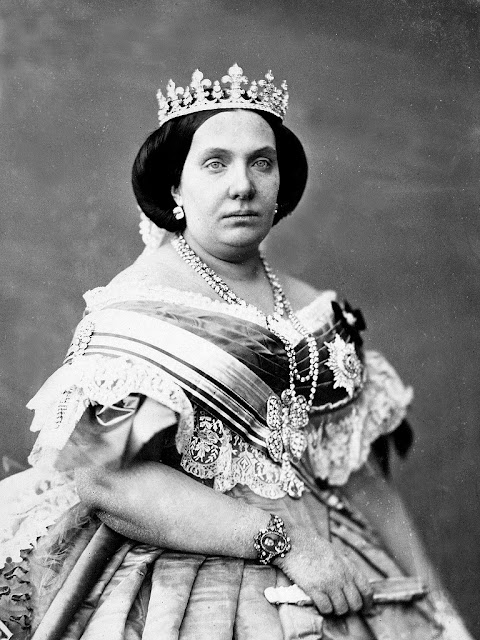Former Queen Isabel of Spain died today in Paris at 9:45 a.m., reports the New York Times. The cause of death was "influenza with complications.
The late queen was the grandmother of King Alfonso XIII. Her daughters, Infantas Isabel, Eulalia, Paz, and her husband, Prince Ferdinand of Bavaria, "were summoned when the end was near," but the dying former sovereign "did not recognize them."
As the Papal Nuncio was not in Paris, the final sacraments were administered by the Vicar of the Church of St. Pierre administered the final sacraments. Queen Isabel died shortly afterward.
Prince Ferdinand "telegraphed" the news of Isabel's death to King Alfonso, the French foreign minister, and "to all the European sovereigns.
The American Embassy, across from the Palace de Castille on the Avenue Kléber, Queen Isabel's residence, was among the first to be informed of the queen's death. Ambassador Porter was "among the first to call and sign the palace register."
It is understood that King Alfonso was "desirous of attending the funeral," but several Spanish ministers did not wish for the King to leave the country.
With Queen Isabel's death, the "final curtain has fallen on a life" of "romance, scandal, court intrigue and stormy episodes."
Infanta Maria Isabel Luisa was born in Madrid on October 10, 1830, the daughter of King Ferdinando VII of Spain and his fourth wife, Princess Maria Cristina of Bourbon-Two Sicilies.
The King "heeding the "urgent solicitations" of his wife, revoked the Salic law, with the "sanction of the Cortes," making Isabel the heir apparent to the throne, replacing Ferdinando's brother, Don Carlos.
Isabel was only three years old when her father died. Maria Cristina was named as Regent during her minority. This action led to the first Carlist "uprising," which led to Don Carlos' banishment.
The political problems continued as the Carlist struggle "tended to stimulate political feeling," leading to further "partisan differences." Eventually, the Queen Regent "retreated into France," leaving Spain with a dictatorial government.
Three years later, thirteen-year-old Isabel was proclaimed the reigning monarch by the Cortes, thus becoming the "tool of contending factions."
At this time, Queen Maria Cristina began the search for a husband for Isabel, who was "forced against her will" to marry her first cousin, Don Francesco d'Asis, Duke of Cadiz, elder son of Ferdinando VII's youngest brother.
The marriage was an "unfortunate one," and Queen Isabel's "conduct caused no end of gossip," throughout Europe.
Two years after her marriage, in 1848, new "insurrectionary movements" arose leading to further political problems. Riots, uprisings, and rebellions led to "the very doors of the royal palace at Madrid."
The Queen's private life continued to provoke "general discontent" throughout the country. A new revolution broke out in September 1868. Two years, later, Isabel renounced her throne in favor of her only son, Alfonso XII, father of the present king.
She fled to Paris where she remained "a conspicuous figure in social life," and enjoyed "great popularity on account of her frank, generous disposition." She was long separated from her husband, who died in 1902.
Queen Isabel's survivors included her three daughters, Infanta Isabel, Infanta Paz, and Infanta Eulalia.

No comments:
Post a Comment